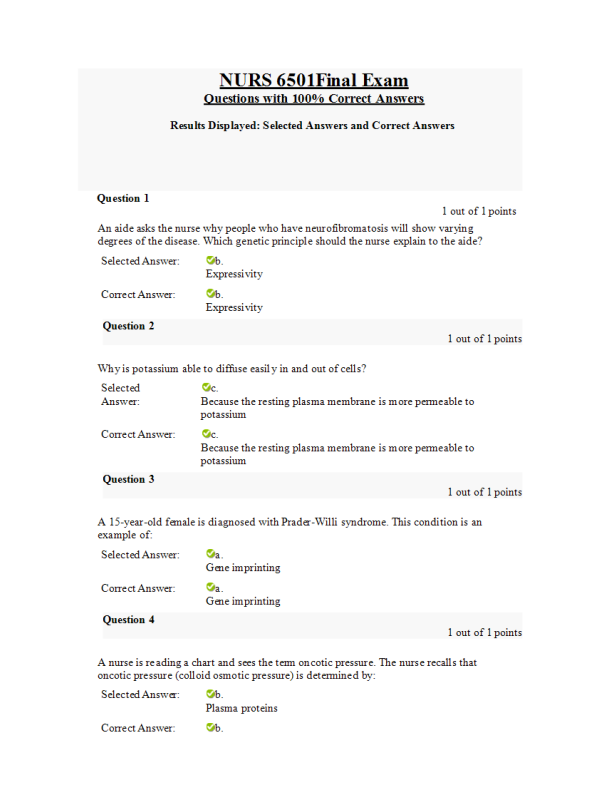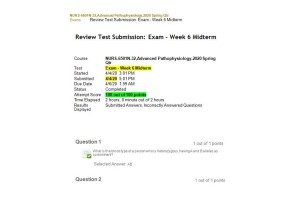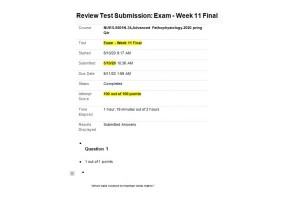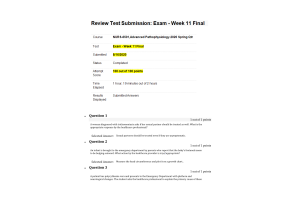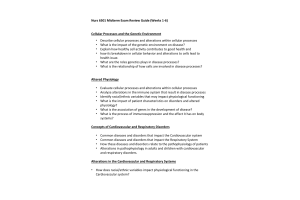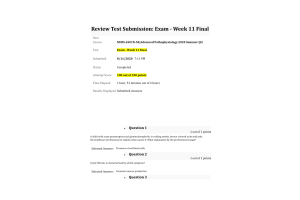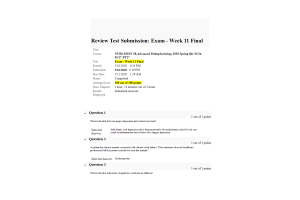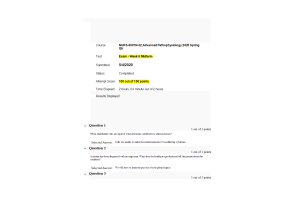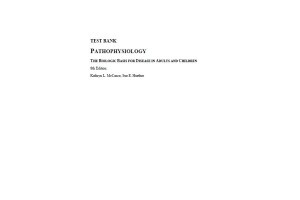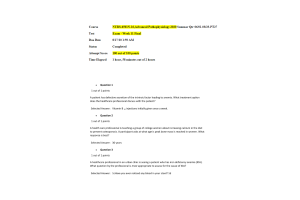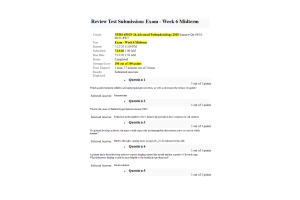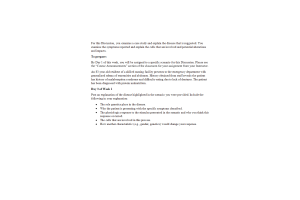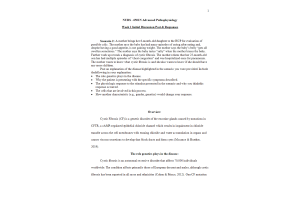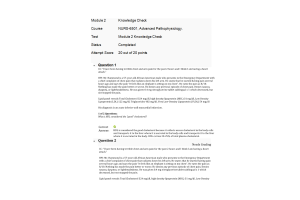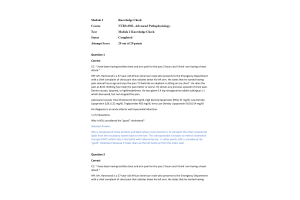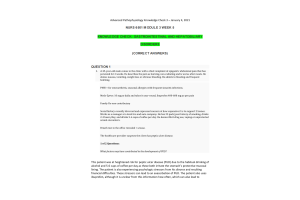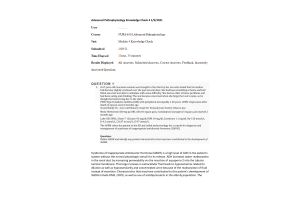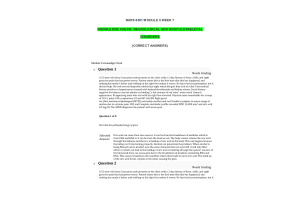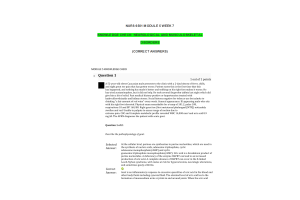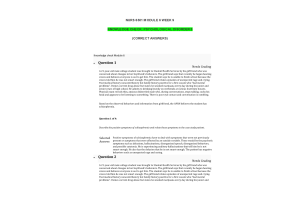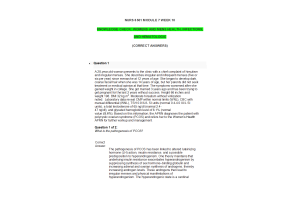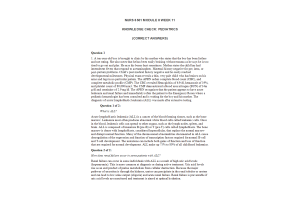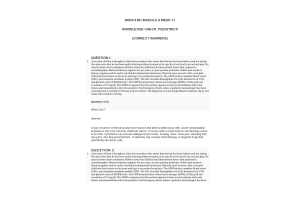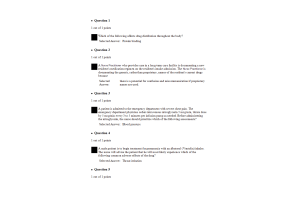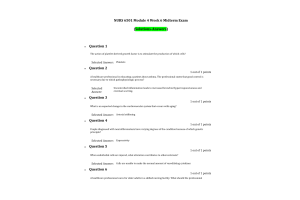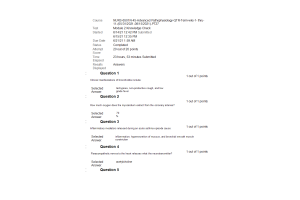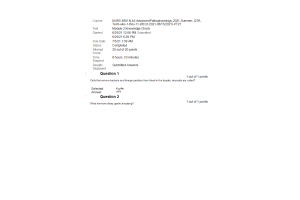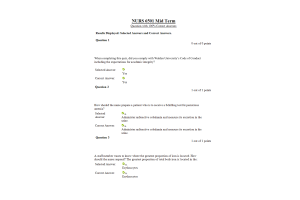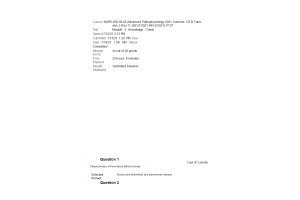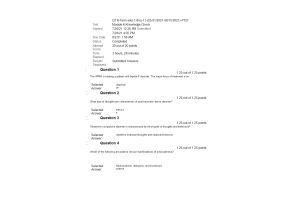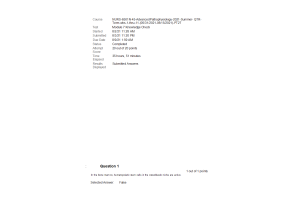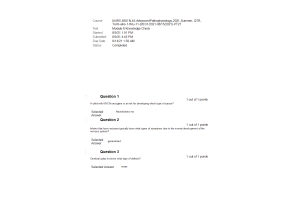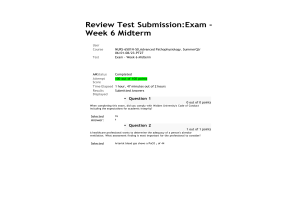NURS 6501 Week 11 Final Exam
- $39.00
- Question: An aide asks the nurse why people who have neurofibromatosis will show varying degrees of the disease. Which genetic principle should the nurse explain to the aide?
- Question: Why is potassium able to diffuse easily in and out of cells?
- Question: A 15-year-old female is diagnosed with Prader-Willi syndrome. This condition is an example of:
- Question: A nurse is reading a chart and sees the term oncotic pressure. The nurse recalls that oncotic pressure (colloid osmotic pressure) is determined by:
- Question: During childhood, the thymus decreases in size, and this is referred toas
atrophy.
- Question: What is the role of cytokines in cell reproduction?
- Question: When a patient asks what causes cystic fibrosis, how should the nurse respond?Cystic fibrosis is causedbyan gene.
- Question: A patient has a heart attack that leads to progressive cell injury that causes cell death with severe cell swelling and breakdown of organelles. What term would the nurse use to define this process?
- Question: A eukaryotic cell is undergoing DNA replication. In which region of the cell would most of the genetic information be contained?
- Question: A nurse is discussing the movement of fluid across the arterial end of capillary membranes into the interstitial fluid surrounding the capillary. Which process of fluid movement is the nurse describing?
- Question: How are potassium and sodium transported across plasma membranes?
- Question: The early dilation (swelling) of the cell’s endoplasmic reticulum results in:
- Question: The ion transporter that moves Na+ and Ca2+ simultaneously in the same direction is an example of which of the following types of transport?
- Question: A newborn male is diagnosed with albinism based on skin, eye, and hair appearance. Which finding will support this diagnosis?
- Question: A patient wants to know the risk factors for Down syndrome. What is the nurse’s best response?
- Question: The student is reviewing functions of the cell. The student would be correct in identifying the primary function of the nerve cell as:
- Question: A 20-year-old pregnant female gives birth to a stillborn child. Autopsy reveals that the fetus has 92 chromosomes. What term may be on the autopsy report to describe this condition?
- Question: Sodium and water accumulation in an injured cell are a direct result of:
- Question: Which of the following mutations have the most significant effect on protein synthesis?
- Question: A 55-year-old male with a 30-year history of smoking is examined for respiratory disturbance. Examination of his airway (bronchial) reveals that stratified squamous epithelial cells have replaced the normal columnar ciliated cells. This type of cellular adaptation is called:
- Question: A nurse is teaching a patient with diabetes how glucose is transported from the blood to the cell. What type of transport system should the nurse discuss with the patient?
- Question: What is the diagnosis of a 13-year-old female who has a karyotype that reveals an absent homologous X chromosome with only a single X chromosome present? Her features include a short stature, widely spaced nipples, reduced carrying angle at the elbow, and sparse body hair.
- Question: A cell is isolated, and electrophysiology studies reveal that the resting membrane potential is –70 millivolts. The predominant intracellular ion is Na+, and the predominant extracellular ion is K+. With voltage change, which of the following would result in an action potential?
- Question: A group of prison inmates developed tuberculosis following exposure to an infected inmate. On examination, tissues were soft and granular (like clumped cheese). Which of the following is the most likely cause?
- Question: A runner has depleted all the oxygen available for muscle energy. Which of the following will facilitate his continued muscle performance?
- Question: When completing this quiz, did you comply with Walden University’s Code of Conduct including the expectations for academic integrity?
- Question: A 19-year-old female presents with genital warts. Which of the following would cause this condition?
- Question: In the majority of cases delayed puberty is due to:
- Question: A 35-year-old female is diagnosed with endometriosis. Suppressing which of the following would be the most appropriate medical treatment for this disease?
- Question: The nurse would anticipate the treatment for pelvic organ prolapse to be:
- Question: While preparing to teach the staff about female anatomy, which information should be included? During the years that a woman is more likely to be sexually active, the vagina mucosa is protected from infection by:
- Question: While speaking to a group of older males, which information should the nurse share? The following is a normal characteristic of aging and the male reproductive system:
- Question: A 40-year-old female presents with cramping and excessive vaginal bleeding. Ultrasound reveals benign uterine tumors in the smooth muscle cells of the myometrium. These tumors are commonly called:
- Question: The most commonly occurring cancer of the female reproductive tract is cancer.
- Changes in the cervical mucus can be used to identify the periods in which a female is most fertile. How should the nurse describe cervical mucus during ovulation?
- Which information indicates the nurse has a good understanding of the menstrual cycle? When estrogen and progesteronelevelsdrop,theendometriumentersthe phase.
- Copy of The nurse would anticipate the treatment for pelvic organ prolapse to be:
- Question: An 18-year-old female is diagnosed with dysmenorrhea. Which of the following symptoms will she most likely experience?
- Question: A 21-year-old female is infected with human papillomavirus (HPV) following unprotected sexual intercourse with a male she recently met. She is now at higher risk of developing which of the following cancers?
- Question: A nurse is teaching the staff about female hormones. Which hormone promotes the formation of channels in the mucus of the cervical os to facilitate sperm movement into the uterus?
- Question: When the nurse describes the duct that carries the ovum from the ovary to the uterus, what is the nurse discussing? The:
- Question: A 20-year-old female presents with pelvic and back pain severe enough to miss work. She reports that the pain occurs with the onset of menses. Physical examination fails to find pelvic pathology. The most likely cause of her condition is:
- Question: When discussing the difference between male and female sex hormones, which information should the nurse include? The major difference between male and female sex hormone
- Question: A 25-year-old female presents with amenorrhea and hirsutism. She is diagnosed with PCOS. Lab testing will most likely reveal:
- Question: A syndrome often associated with cystocele is:
- Question: An example of a parasitic STI that is transmitted through close skin-to-skin contact is:
- Question: Symptoms of prostatitis are similar to symptoms of:
- Question: A nursing student asks the nurse where the glands of Montgomery are located. How should the nurse reply? The glands of Montgomery are located in the:
- Question: A 23-year-old sexually active female presents with white copious discharge and itch. She is diagnosed with yeast vaginitis caused by overgrowth of which microorganism?
- Question: When a staff member asks which structure secretes glucose-rich fluid into the semen, how should the nurse respond?
- Question: A middle-aged male speaks to his physician about benign BPH. He reveals that his father was recently diagnosed with this condition, and he wants to know if he could have it. The physician tells him that a common complaint from men with mild to moderate BPH is:
- Question: A 38-year-old female was recently diagnosed with cancer. She learns that her mother almost miscarried while pregnant with her and was given diethylstilbestrol (DES) to prevent it.
Which of the following cancers does she most likely have?
- Question: Which of the following signs is usually the first clinical manifestation of breast cancer?
- Question: When a teenager asks what makes the breast grow, what is the nurse’s best response? The hormone that promotes breast development during puberty is:
- Question: Progesterone is often referred to as “the hormone of pregnancy,” and the patient asks what this phrase means. How should the nurse respond? Progesterone is the hormone of pregnancy because it:
- Question: A 35-year-old female presents with infertility and gradual blindness. She reports that she has otherwise been healthy. History reveals that she was promiscuous and had unprotected sexual intercourse several times when she was younger. She now has neurological involvement. Which of the following sexually transmitted infection (STI)does she most likely have?
- Question: When a staff member asks the nurse what the thick middle layer of the uterine wall is called, what is the nurse’s best response? The:
- Question: is inflammation of the glanspenis.
- Question: A 21-year-old male presents with inflammation of the testes. He has a high fever and edema and redness of the testes. Which organism is the most likely the cause of his symptoms?
- Question: A 56-year-old female is in menopause. She has ovarian failure. While checking the lab results, which of the following will the nurse find?
- Question: When a patient who is trying to get pregnant asks where the usual site of fertilization is, how should the nurse respond? The:
- Question: A student asks the instructor which of the following hormones stimulates follicular maturation. How should the instructor respond?
- Question: A 40-year-old male is concerned about the possibility of developing prostate cancer. He reports that his father died of prostate cancer, and he wants to take all preventive measures. He is told to consume a diet low in:
- Question: A patient asks the nurse what is the most sensitive area of the penis. What is the nurse’s best answer? The area of the penis with the most nerve endings is the:
- Question: What term should the nurse use when discussing male sex hormones collectively?
- Question: When the nurse is teaching about the menstrual cycle, which information should be included? Menstruation is followed by the phase of the menstrual cycle.
- Question: When completing this quiz, did you comply with Walden University’s Code of Conduct including the expectations for academic integrity?
